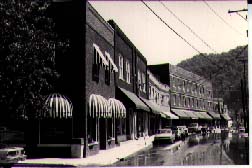 |
|
| Home | Town | History | People | Events |
| Media | Schools | Government | Links | Back to New |
| The Tug Valley | Historic Landmark | The Floods | The Movie | Mountain Culture | Mining Life |
| The Legacy | The Battle of Matewan | The Feud | Quest for Resources | More Coming Soon | More Coming Soon |
"Muscle and blood, skin and bones," sang Merle Travis mournfully of the mining life, a "mind that's weak and a back that's strong." Yet despite the rigors of the bituminous coal miner's profession, aged veterans from the hand-loading era remember their work with a curious affection. The special relationship between man and mineral defined the parameters of the mining life. Although coal mining in southern West Virginia was dark, dirty, and dangerous work, something about it appealed to many a hardworking coal loader.
Before the widespread introduction of sophisticated underground machines into the process around World War II, coal mining was a highly labor-intensive industry. Thousands of workers laboriously extracted the mineral from the unwilling earth. Yet the desolate hills and hollows of pre-industrial southern West Virginia were still largely uninhabited, offering no such teeming workforce. Thus as the railroads snaked along the river bottoms into the coal fields in the late 19th century, companies were forced to import their labor and set up mining communities, literally overnight replacing silent mountains and roaring streams with a boisterous new society of steel, smoke and sinew.
To these small mining towns came thousands of blacks, fleeing the Deep South's endemic segregation, sharecropping, prejudice, and poverty. There came, too, thousands of eastern Europeans fleeing religious persecution and political revolution, escaping to new homes in the coalfields. Thus coal towns were filled with a rich and colorful milieu of race, class, color and religion.
Underground, each man was his own boss, for in the hand-loading era coal miners were paid not by the hour, but by the ton. This was a powerful incentive which meant that better workers made more money. Merle Travis's pithy observations notwithstanding, coal mining was a highly skilled trade. Each miner had to timber the roof of his worksite, undercut the broad face of the ebony seam, drill a deep hole upward into the coal, pack it with black gunpowder, shoot the charge, and then laboriously hand-load the dislodged lumps of coal. Performing these complex and hazardous tasks by hand in the pitch-black darkness was painstaking and exacting. Each coal miner produced a finished product in which he could take pride. This was craft work. Moreover, in an age which witnessed the bewildering move from farm to factory for many new industrial workers, coal miners at least still worked the soil with their hands, "harvesting" the mineral. Despite the rough and rugged lifestyle commonly associated with other frontier industries, coal miners had a sense of worth and dignity of labor.
Even the ever-present danger from gas and dust explosions and roof falls helped to strengthen the special relationship between man and mine, for only the most skilled men could be trusted to perform the delicate operation skillfully and safely. Coal miners tempted death each workday, and the men knew that their survival depended upon the skill of their fellow workers on the shift. Veteran miners shared something that outsiders could never grasp, like the camaraderie of combat-hardened infantrymen.
Also helping to build close ties among the workers was the very nature of the small and isolated mining towns which clung to hillsides, dotted ravines, and sprawled promiscuously along creek beds throughout the coal fields. In these tiny "walking communities," work and home were closely inter-related. Often the railroad was the only way into or out of the towns, whose miners houses perched neatly in terraced rows on the steep rugged hillsides. This isolation bred close-knit ties of family, neighborhood, church, and home. Forbidden by a hoary superstition from entering the mines, coalfield women built elaborate support networks based around the work rhythms of the weekly household chores.
Everyone knew everyone else, and today old-timers especially miss this fierce sense of community. Although the towns were segregated by race and ethnicity, such distinctions vanished at the two most predominant institutions in the community, the mine and the company store. Infrequent incorporated towns like Matewan supplied commercial and entertainment options not often available in the stark company-run industrial towns.
Because conditions varied widely from town to town, generalization is difficult and imprecise. Research reveals a wide disparity between trim model towns, with bright gardens, sidewalks and verdant scenery, to squalid camps of tarpaper shacks patrolled by armed company thugs. Although it is common to decry conditions in the mining towns, even the roughest camps were probably superior to the tenement ghettos which the immigrants encountered in New York, or to the tenant-farming huts of southern black cotton workers.
Relations between management and miners also varied widely, but helping to lessen tensions was the widespread practice of the early operators actually living in the mining town itself. Moreover, when coal tonnage stayed high, there was seldom labor unrest. But owing to the nature of the industry, sudden drops in demand could throw miners out of work, producing the potential for trouble. The rural nature of the coal fields meant that there was little or no law enforcement, and county government was nonexistent or inefficient. Although such violence was, it must be noted, hardly the normal state of affairs, ties between miners and company could deteriorate rapidly and with tragic consequences, such as the unpleasantness in Matewan during the spring of 1920.
Stuart McGehee is an Assistant Professor of
History at Bluefield College in West Virginia and is the archivist for the
Eastern Regional Coal Archives.
| Home | Town | History | People | Events |
| Media | Schools | Government | Links | Back to New |

Back to matewan.com
matewan@a-aautoparts.com